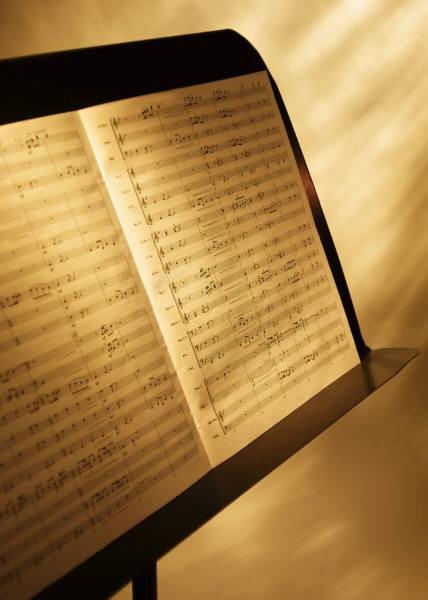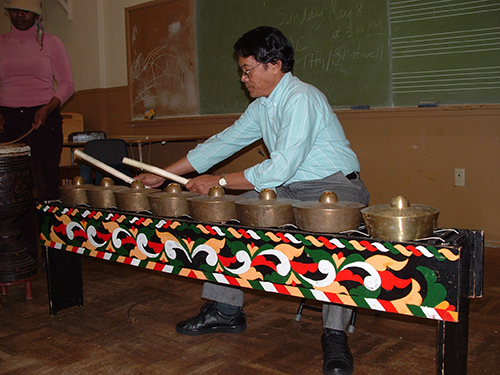Los Obispos MS
Band Department Band Syllabus

Middle School – Band
Los Obispos MS Band
Purpose:
The Beginning Band Syllabus is intended to facilitate the growth and development of sixth grade students into proficient musicians. The purpose of the
Syllabus is to ensure that the teaching of Beginner Band is a coordinated effort.
Timeline:
Every effort should be made to follow the timeline as closely as possible. However, it is recognized that some instruments will progress faster or slower than the timeline allows. The director may adjust the timeline while keeping the end goal in mind.
New material should not be introduced until the majority of the students have a working knowledge of the material covered. Good characteristic sounds and rhythmic stability are the most important skills in beginning band.
Texts:
The Los Obispos Middle School Band Syllabus is designed to follow the Premier Performance Method Book supplemented by any other beginner method book. However, the director/instructor may at any time supplement these texts with outside materials and texts related to each instrument.
Appendix:
The Band Syllabus is designed to give the director all the information and hand-outs needed to assist in teaching the instrument. However, the director/instructor may supplement as seen fit, as long as the basic instruction is the primary goal.
The program goals are to provide the best music education and a positive learning environment for all students. The classes are scheduled heterogeneously and if possible, are divided up homogeneously, on a daily basis. Goals for the students are:
1. To encourage appreciation and importance of a music education.
2. To develop critical listening skills.
3. To develop their attention span and concentration.
4. To develop strong music skills including, but not limited to:
a. Embouchure
b. Tone Production and Breath Support
c. Technique (both individual and ensemble)
d. Music Theory
e. Correct posture and playing position f. Instrument maintenance
5. To develop life skills such as teamwork, responsibility and self-discipline through individual and group activities
I. Sound:
Tone production continues to be a top priority and each student must be able to produce and sustain a characteristic sound on their instrument. Continued careful attention must be given to the following basic fundamental:
A. Set and maintain proper embouchure through a basic range and slurred/tongued intervals
1. Brass- 3/4 octave (F-D)
2. Woodwinds- 2 Octaves
3. Percussion- Keyboard 2 Octave Range
4. Correct hand position and proper instrument carriage. B. Breath Control
1. Maintain unwavering sustained sound at dynamic levels:
p, mp, mf, and f.
a. Display proper breathing techniques b. Perform with proper breath support
2. Intonation
a. All brass students must be able to buzz on their mouthpiece the correct/appropriate pitch that will enable them to maximize pitch accuracy and tone production.
b. TLW be able to sing pitches, scales and/or melodies in order to help enhance ear training.
c. TLW understand how to use a tuner and appropriately adjust their instrument to the pitch, either flat or sharp.
d. TLW be able to start, sustain and release tones with a characteristic sound and intonation.
e. TLW understand the importance of good intonation.
II. Posture
A. Display correct postures in three positions:
1. Position 1- Resting Position
2. Position 2- Ready Position
3. Position 3- Playing Position
III. Articulation
1. TLW be able to start, sustain and release tones with a characteristic tone and intonation.
2. TLW understands the importance of good intonation.
A. The start of the sound.
1. Tonguing:
i. Start the sound with the syllable "too", small contact, firm air.
B. Releases
1. Director must ensure that the student does not stop the air with the tongue.
2. Releases are to be done without pitch or quality alteration.
C Style
IV. Rhythm
1. Produce staccato and legato quarter notes at MM quarter note =62·72.
2. Patterns and Facility- At MM quarter note =72-82, produce diatonically the Above patterns in both quarter notes and eighth notes.
A. TL W internalize the subdivision of the beat.
B. TLW sight-read at least grade 1 music using a steady pulse
1. Count out loud, clap, write and play all combinations and tie groupings for the following notes and their corresponding rests; whole half,
quarter, eighth, dotted half, and dotted quarter.
2. Exhibit a working understanding of quarter note meters. Understand the relative value of note length MS and rests. Understand how meter sign affects time beating as specified.
3. Percussionists are to demonstrate ability and knowledge of sixteenth notes and rolls in addition to parts of the above that are applicable.
V. Technique
A. Chromatic Studies-All students shall perform the chromatic scale in eighth notes at MM
quarter=60.
1. Flute - 2 Octaves F-F
2. Clarinets 2 Octaves E-E
3. Oboes 1 Octave D-D
4. Bassoons 1 1/2 Octave F-Bb
5. Bass Clarinets 2 Octaves E-E
6. Saxophones 2 Octaves D-D
7. Cornets 1 + Octaves G-D
8. French Horns 1 1/2 Octaves C-G
9. Trombones 1 1/2 Octaves F-C
10. Euphoniums 1 1/2 Octaves F-D
11. Tubas 1 1/2 Octaves F-C
12. Percussion 2 Octaves F-F
B. Major Scales (Concert Pitch)- All students shall perform the following major scales in all-region scale pattern at MM of quarter note=60 beats per minute.
1. Flute- Concert Scales in 2 8vas: C, F, Eb, Db in 1 8va: Bb, Ab, G
2 Oboe- Concert Scales in 2 8vas: C, Bb, Db in 1 8va: F, Eb, A,. G
3. Bassoon Concert Scales in 2 8vas: C, Bb, Eb. Db in 1 8va: F, Ab,G
4. Clarinet Concert Scales in 2 Octaves: F, Bb, Eb. Ab in 1 Octave: C, Db, G
5. Bb Bass Clarinet Concert Scales in 2 8vas: F, Eb in 1 Octave C, Bb, Ab, Db, G
6. Saxophones Concert in 2 8vas: Eb F, 1 8va: C, Bb, Ab, Db, G
7. Trumpet/Trombone/Baritone/Tuba-Concert Scales in 2 8vas: F In 1 8va.· C, Bb, Eb. Ab, Db, G
8. French Horn Concert Scales in 2 8vas: Bb 1 8va: C, Bb, Eb. Ab, Db, G
9. Percussion:
a. Understand and apply flow sticking patterns b. Learn all 13 Rudiments at quarter note =100
c. Keyboards: Concert Scales in 2 8vas: C, Bb, Eb. Ab, Db, G
VI. Practice and Study Habits
A. TL W demonstrate in class a proper daily warm-up routine with sitting posture and hand position correctly maintained.
B. TLW understand and use a definite system in learning new materials. This is to include non playing study of problems: realization of difficult rhythms, articulations and
intervals: realization of necessity for "drill" done at a manageable slow motion and built to a performance speed over a period of time.
C. TLW understand and demonstrate in practice routines the amount of effort needed. Goal setting and evaluation of progress towards that goal (short term and long term) are of primary importance rather than elapsed time. Necessity and purpose of repetition, when required to accomplish goal, is to be accepted.
D. TLW Communicate to the parents the importance of developing home studying and practicing habits. Teachers must be in contact with parents on a consistent basis.
VII. Practical Knowledge
A. TLW demonstrate in class daily proper rehearsal etiquette, posture, care of and use of rehearsal room equipment.
B. TLW be able to write and define all terms that appear in appropriate level music being used during the term.
C. TLW show through identification an understanding of melody, harmony, countermelody and accompaniment parts of music being used during the term.
D TLW be able to write note names with corresponding rests: Identify and use 7 key signatures: Explain the rule for accidentals: Recognize half and whole step intervals .
E. TLW show by demonstration, your own instrument's transposition and necessary knowledge of concert pitch terminology.
VIII. Maintenance
A. TLW understand and demonstrate daily, proper instrument care and maintenance:
know and avoid the "DO NOTS" of each instrument's handling. B. TLW demonstrate correct assembly of the instrument.
C. Holding instrument properly while playing and resting.
D. TL W disassemble and properly clean instrument prior to storing daily. E. Proper knowledge of rotating, breaking-in and storage of reeds
F. Knowledge of cleaning and lubricating instruments on a consistent basis. IX. Other Items
A. Performances
i. TLW actively participate in all scheduled performances and rehearsals throughout the school year.
ii. TLW demonstrate proper concert and rehearsal etiquette. B. Listening
i. Recordings of accomplished artists should be used often to establish desired fundamental concepts (i.e. tone, technique, style, musicality, etc.) Individual teachers should play along and/or demonstrate often.
ii. TLW demonstrate the ability to evaluate self-recordings and ensemble recordings.
iii. TLW make a serious effort to attend outside performances.
"THE QUALITY OF INSTRUCTION IS DETERMINED BY THE STUDENTS' ABILITY TO INDEPENDENTLY APPLY ACQUIRED KNOWLEDGE AND SKILLS"

Joe Martinez
Los Obispos Middle School
Director of Bands
United Independent School District
(956) 473-7823
joe.martinez@uisd.net


 Additional settings for Safari Browser.
Additional settings for Safari Browser.


